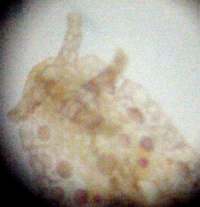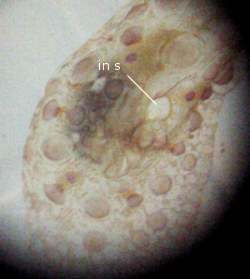Petalifera ramosa from the Dominican Republic
May 17, 2003
From: Elianny Dominguez

Dear Bill,
Here are some pictures of an opistobranch I found at one of my collecting sites [44f], on Udotea, on the Caribbean coast of the Dominican Republic, in a locality named La Caleta. It is 7 mm long and 2 mm width.
It is an anaspidean much like Dolabrifera dolabrifera. The posterior half of the animal is broader than the head region. On the first picture, you can see the head, with the rhinofores. In the second picture [lower left], you can see the coloration of the body. It has a lot of spots of different colors and sizes. And also, the dorsal opening of parapodial chamber. And on the third picture [lower right], you can see what got my attention. In the centre, you can see, what I guess are gills?? In the shape of a small anemone, with seven thin projections. This animal has two of this gills??, on both side of the parapodial chamber. One is bigger than the other. The one on the picture is the biggest one, and it is on the left side. The smaller one is on the right side. And they are both retractible. Is there a group of anaspideans with external and retractible gills, like the ones on Dorids?
Kind regards,
Elianny Dominguez.
eliannydominguez@hotmail.com


Dear Eli,
At 7mm long this is indeed a juvenile. It is Petalifera ramosa whih seems to have a world-wide distribution. The anemone-like 'gill' is the retractile papillae that are found at the tip of the conical tubercles that cover the body. Have a look at other messages on this page to see the papillae fully extended. I am not sure of the function of these papillae but perhaps they do have a function as secondary gills.
The 'real' gill is essentially internal, lying in what is left of the mantle cavity, which is itself inside the parapodial cavity. I have labelled the anterior 'inhalent opening' into the parapodial cavity.
Best wishes,
Bill Rudman
Related messages
-
Re: Petalifera ramosa with probable eggs [2]
From: David and Leanne Atkinson, January 12, 2009 -
Re: Petalifera ramosa with probable eggs [1]
From: Leanne & David Atkinson, January 12, 2009 -
Re: Petalifera ramosa with probable eggs
From: Leanne & David Atkinson, February 1, 2008 -
Re: Petalifera ramosa with probable eggs
From: Leanne & David Atkinson, November 30, 2007 -
Petalifera ramosa with probable eggs
From: Ron Greer, November 29, 2007 -
Petalifera ramosa mating?
From: Leanne & David Atkinson, November 1, 2007 -
Petalifera ramosa and its papillae
From: Leanne & David Atkinson, May 10, 2006 -
Petalifera ramosa from the Caribbean
From: Les Wilk, November 4, 2005 -
Petalifera ramosa from Port Stephens, NSW
From: Bruce Potter, November 2, 2005 -
Petalifera ramosa? from Eilat, Red Sea
From: Binyamin Koretz, May 11, 2005 -
Re: sea hare eggs
From: Binyamin Koretz, May 11, 2005 -
Petalifera ramosa from Saba,
From: Kelly Griggs, January 27, 2005 -
Petalifera ramosa from Bahamas
From: Lindsay Warren, March 23, 2004 -
Petalifera ramosa from Brunswick Heads
From: Denis Riek, December 19, 2003 -
Petalifera ramosa from Jamaica
From: Ross W. Gundersen, October 19, 2003 -
Petalifera ramosa from the Caribbean
From: Bill Rudman, April 3, 2003 -
Petalifera ramosa from the Bahamas
From: Colin Redfern, April 2, 2003 -
Petalifera ramosa Baba from Japan
From: Jun Imamoto, February 5, 2003 -
Petalifera ramosa on Sea Grass
From: Erwin Koehler, February 8, 2001 -
Re: Petalifera from Pemba Island
From: Ron Velarde, February 7, 2001 -
Petalifera from Pemba Island
From: Bernard Picton, February 4, 2001 -
Petalifera ramosa from Lifou
From: Bill Rudman, February 4, 2001 -
Petalifera ramosa - additional images
From: Ron Greer, May 19, 2000 -
Re: Petalifera ramosa from New South Wales
From: Ron Greer, December 7, 1999 -
Petalifera ramosa from New South Wales
From: Ron Greer, December 3, 1999
